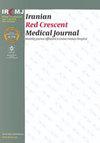Static Analysis and Design of Innovative Porous Lumbar Interbody Cages
IF 0.2
4区 医学
Q3 MEDICINE, GENERAL & INTERNAL
引用次数: 0
Abstract
Background: Interbody discs play a major role in maintaining the spine and skeleton structures which may undergo damage. If damage is so severe that the disc cannot be repaired, implants, known as “interbody cages”, should be used. Objectives: The present study aimed to propose a novel design with proper strength and resistance against axial disc torques. Methods: The design and analysis of innovative anatomical cages comprised two stages, namely, cage design according to three different models and finite element analysis (FEA). The designs were based on the spine of a 15-year-old teenager without lumbar disc disease. To model the vertebrae, computed tomography )CT( scans and Digital Imaging and Communications in Medicine (DICOM) files were entered into Mimics Version 10.01 (Materialise Inc., Leuven, Belgium); then, the L4 and L5 spinal segments were modeled. Results: The implants were fixed to the bottom level and subjected to a net force of 1000 N. Additionally, a moment load of 7.5 Nm in flexion, extension, axial rotation, and lateral bending was applied in these three cage models. Considering the application of 1000-N force, maximum and minimum stress and strain distribution rates were presented in three honeycomb, Islamic architecture, and porous gyroid cages. Conclusion: Novel designs for lumbar cages were considered to achieve damping capacity, light weight, and high resistance. Considering the characteristics of the honeycomb, Islamic architecture, and gyroid structures, optimal designs were proposed for lumbar cages to achieve adequate strength and resistance against axial disc torques under normal conditions.创新型多孔腰椎间融合术的静力分析与设计
背景:椎间盘在维持可能受损的脊椎和骨骼结构方面发挥着重要作用。如果损伤严重到椎间盘无法修复,则应使用被称为“椎间笼”的植入物。目的:本研究旨在提出一种具有适当强度和抵抗轴向椎间盘扭矩的新型设计。方法:创新解剖笼的设计和分析包括两个阶段,即根据三种不同模型的笼设计和有限元分析。这些设计基于一名15岁未患腰椎间盘疾病的青少年的脊椎。为了对椎骨进行建模,将CT(扫描和医学数字成像与通信(DICOM))文件输入到Mimics Version 10.01(Materialise股份有限公司,Leuven,Belgium)中;然后,对L4和L5脊柱节段进行建模。结果:植入物固定在底部水平面上,并承受1000N的净力。此外,在这三个笼模型中施加了7.5 Nm的屈曲、伸展、轴向旋转和侧向弯曲力矩载荷。考虑到1000-N力的作用,给出了三个蜂窝、伊斯兰结构和多孔陀螺笼中的最大和最小应力和应变分布率。结论:新型设计的腰椎保持器具有阻尼能力、重量轻、阻力大的特点。考虑到蜂窝、伊斯兰结构和陀螺结构的特点,提出了腰椎保持架的优化设计,以在正常条件下获得足够的强度和抵抗轴向椎间盘扭矩的能力。
本文章由计算机程序翻译,如有差异,请以英文原文为准。
求助全文
约1分钟内获得全文
求助全文
来源期刊

Iranian Red Crescent Medical Journal
MEDICINE, GENERAL & INTERNAL-
CiteScore
1.16
自引率
0.00%
发文量
0
期刊介绍:
The IRANIAN RED CRESCENT MEDICAL JOURNAL is an international, English language, peer-reviewed journal dealing with general Medicine and Surgery, Disaster Medicine and Health Policy. It is an official Journal of the Iranian Hospital Dubai and is published monthly. The Iranian Red Crescent Medical Journal aims at publishing the high quality materials, both clinical and scientific, on all aspects of Medicine and Surgery
 求助内容:
求助内容: 应助结果提醒方式:
应助结果提醒方式:


